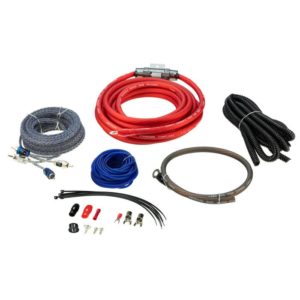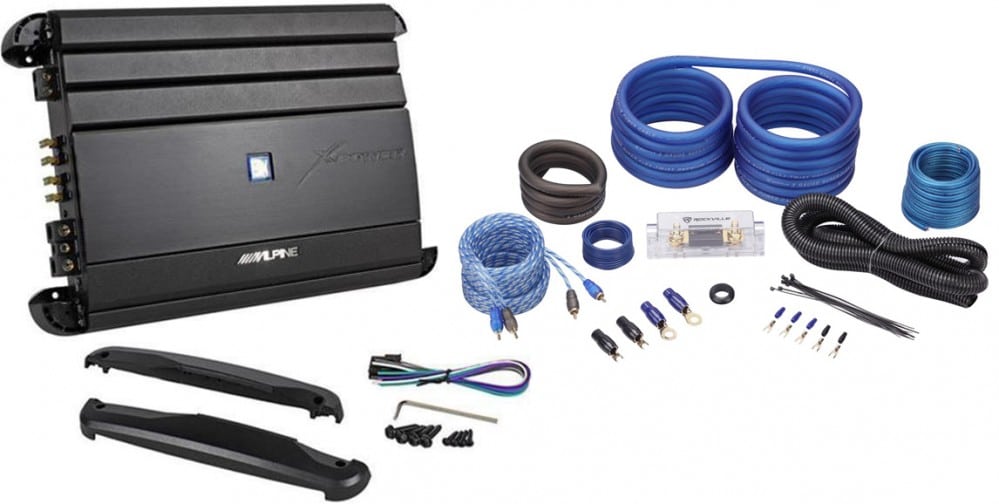Once you have selected your amp, you need to select a car audio amplifier kits to wire it into your vehicle. The amp kit includes power and ground wire, a fuse, remote turn on wire, RCAs, speaker wire, and in some cases a few extras or a few of these components missing depending on the kit you get.
Car audio amplifier installation kits, wiring kits, or amp kits, usually include all or most of the things you need to install your amp, but you don’t need the full kit if you already have most of what you need; you can go buy whatever you’re missing separately. It’s usually a lot cheaper to get a kit if starting from nothing. Also make sure the kit you buy includes what you need. For example: most kits only come with one set of RCAs. This is fine for a sub installation, but you will need another pair if you plan on doing 4 speakers on a 4 channel amp.
What do car audio amplifier kits include?

Car audio amplifier kits will include the wires, cables, fuse holders, and connectors you need to install your amp. Some include more pieces than others. This 4 gauge Scosche Vector series OFC amp kit includes everything you need to get your system hooked up and sounding good. You can get cheaper kits, but the wires won’t be true AWG size, will most likely be copper clad aluminum (CCA), won’t carry current as well as name brand pure copper kits, and will have cheap RCAs.
It’s definitely worth the extra price to upgrade to a high quality kit like the Scosche Vector Series. When looking for a pure copper amp kit, some companies will call it 100% oxygen free copper, pure copper, or OFC. These provide the best conductivity and least resistance compared to CCA.
CCA wire can be used, too, but will be a little larger gauge and from my experience, corrodes faster. Using high quality connections and proper crimping techniques help with that, though.
Car Audio Amplifier Kits include the following:
Power Wire
The Power Wire will be the longer of the two thick wires in your kit. It runs from your battery to your amp. See the chart below or calculator (click here) to determine the power and ground wire size you need for your installation.
Ground Wire
The Ground Wire will be the shorter of the two thick wires, usually less than 3 feet. The ground wires goes from your amp to the chassis or body of your car or back to the battery. Be sure to take the Ground Wire length into account in your wire size calculations, especially if you run the ground back to the battery with the Power Wire.
Remote Wire
The Remote Wire is the long single (primary) wire in the kit, usually blue. This wire runs from a switched 12V source, like the remote turn on wire on the back of aftermarket radios, to your amp.
Speaker Wire
Speaker Wire is the wire that is actually two wires together. Obviously this goes from your amp to your speakers, one side to positive, one side to negative. Some kits do not include speaker wire. KnuKonceptz makes a good speaker wire at a great price.
RCA Cable(s)
The RCAs are signal cables that run from the output on the back of your head unit, or low level converter (more on that later), to the input on the amp. These probably vary more than wire quality does. You don’t want to skimp on RCAs or you could possibly get engine noise or other signal quality problems. Use high quality RCAs like the Scosche Delta Series here.
Fuse Holder and Fuse
The Fuse protects your car, battery, and amp from getting fried if something goes wrong (actually it protects the wire itself, so the fuse rating in your amp kit can be compared to the fuse rating on your amp to determine if the amp kit will work for you). ALWAYS install the Fuse Holder and Fuse and as close to the battery as possible, usually no more than 18″.
Various Connectors and Terminals
Most kits will come with wire connectors and terminals so you can connect the wires where they need to go. A lot of amps don’t require special connectors, so these may not be used for your install.
How to pick what kit you need
Amp kits are sized by the power and ground wire. For example, if you buy an 8 gauge amp kit, the power and ground wire will be 8 gauge. The speaker wires are usually 12 AWG or less, and the remote wire is usually 18 AWG.
The chart below shows the basic wire size you need based on your power requirements assuming the kits you are looking at are a good brand with true AWG copper wire:
Note that you need to use the total length of your power AND ground wire for the length measurement.

How to Use the Chart and Calculate Wire Size
Just match the max amperage or fuse rating on your amp to the amperage on the chart, find out how long your wire is going to be, and you can find out what size wire you need. Use the general equations below to determine the current your amplifier will pull.
For a Class D amp (assumes 75% amp efficiency and 13.8 volts):
\begin {aligned}
Amps={Total \> RMS \> Power \above {2pt} 0.75 \> x \> 13.8 \>VDC}
\end {aligned}
For a Class AB amp (assumes 50% amp efficiency and 13.8 volts):
Amps={Total \> RMS \> Power \above {2pt} 0.50 \> x \> 13.8 \>VDC}
You can also find a calculator here that will tell you the minimum wire size needed for your installation.
Jump up a wire gauge size if you are ever unsure, are going with a cheap unknown amp kit, or if you go with CCA instead of OFC wire.
It’s recommended to go up two wire sizes from what the chart above shows if you use CCA in order to achieve less resistance. You can’t go wrong by getting bigger wire (smaller gauge) just don’t ever get smaller than recommended. The wire will pull more current than it’s designed for and possibly cause a fire if you use a wire that is too small. The inline fuse will blow in most cases, and if that happens, don’t swap it out for a bigger one! Fix the issue, and upgrade the wiring.

I really like and appreciate your article post.Really looking forward to read more. Fantastic. Bognar
Thanks Bognar/William (I too have many names). I know this response is years later, but I have updated this article as well as a lot of my site if you want to check it out!
Let me know if you have any questions.